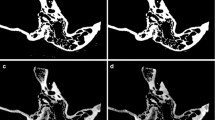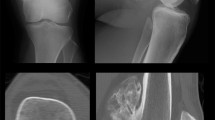Abstract
Purpose
An increasing number of orthopaedic surgeons are using computer aided planning tools for bone removal applications. The aim of the study was to consolidate a set of generic functions to be used for a 3D computer assisted planning or simulation.
Methods
A limited subset of 30 surgical procedures was analyzed and verified in 243 surgical procedures of a surgical atlas. Fourteen generic functions to be used in 3D computer assisted planning and simulations were extracted.
Results
Our results showed that the average procedure comprises 14 ± 10 (SD) steps with ten different generic planning steps and four generic bone removal steps.
Conclusions
In conclusion, the study shows that with a limited number of 14 planning functions it is possible to perform 243 surgical procedures out of Campbell’s Operative Orthopedics atlas. The results may be used as a basis for versatile generic intraoperative planning software.


Similar content being viewed by others
References
Lundstrom C, Rydell T, Forsell C, Persson A, Ynnerman A (2011) Multi-touch table system for medical visualization: application to orthopedic surgery planning. IEEE Trans Vis Comput Graph 17(12):1775–1784. https://doi.org/10.1109/TVCG.2011.224
Fadero PE, Shah M (2014) Three dimensional (3D) modelling and surgical planning in trauma and orthopaedics. Surgeon 12(6):328–333. https://doi.org/10.1016/j.surge.2014.03.008
Hara S, Mitsugi M, Kanno T, Nomachi A, Wajima T, Tatemoto Y (2013) Three-dimensional virtual operations can facilitate complicated surgical planning for the treatment of patients with jaw deformities associated with facial asymmetry: a case report. Int J Oral Sci 5(3):176–182. https://doi.org/10.1038/ijos.2013.48
Hassani H, Cherix S, Ek ET, Rudiger HA (2014) Comparisons of preoperative three-dimensional planning and surgical reconstruction in primary cementless total hip arthroplasty. J Arthroplast 29(6):1273–1277. https://doi.org/10.1016/j.arth.2013.12.033
Hirao M, Ikemoto S, Tsuboi H, Akita S, Ohshima S, Saeki Y, Yoshikawa H, Sugamoto K, Murase T, Hashimoto J (2014) Computer assisted planning and custom-made surgical guide for malunited pronation deformity after first metatarsophalangeal joint arthrodesis in rheumatoid arthritis: a case report. Comput Aided Surg 19(1-3):13–19. https://doi.org/10.3109/10929088.2014.885992
Lee SW, Shinohara H, Matsuki M, Okuda J, Nomura E, Mabuchi H, Nishiguchi K, Takaori K, Narabayashi I, Tanigawa N (2003) Preoperative simulation of vascular anatomy by three-dimensional computed tomography imaging in laparoscopic gastric cancer surgery. J Am Coll Surg 197(6):927–936. https://doi.org/10.1016/j.jamcollsurg.2003.07.021
Hu Y, Malthaner RA (2007) The feasibility of three-dimensional displays of the thorax for preoperative planning in the surgical treatment of lung cancer. Eur J Cardiothorac Surg 31(3):506–511. https://doi.org/10.1016/j.ejcts.2006.11.054
Shiozawa M, Sata N, Endo K, Koizumi M, Yasuda Y, Nagai H, Takakusaki H (2009) Preoperative virtual simulation of adrenal tumors. Abdom Imaging 34(1):113–120. https://doi.org/10.1007/s00261-008-9364-z
Handels H, Ehrhardt J, Plotz W, Poppl SJ (2000) Virtual planning of hip operations and individual adaption of endoprostheses in orthopaedic surgery. Int J Med Inform 58-59:21–28
Ribeiro CH, Severino NR, Fucs PM (2013) Preoperative surgical planning versus navigation system in valgus tibial osteotomy: a cross-sectional study. Int Orthop 37(8):1483–1486. https://doi.org/10.1007/s00264-013-1960-z
Cartiaux O, Paul L, Francq BG, Banse X, Docquier PL (2014) Improved accuracy with 3D planning and patient-specific instruments during simulated pelvic bone tumor surgery. Ann Biomed Eng 42(1):205–213. https://doi.org/10.1007/s10439-013-0890-7
Cartiaux O, Docquier PL, Paul L, Francq BG, Cornu OH, Delloye C, Raucent B, Dehez B, Banse X (2008) Surgical inaccuracy of tumor resection and reconstruction within the pelvis: an experimental study. Acta Orthop 79(5):695–702. https://doi.org/10.1080/17453670810016731
Bellanova L, Paul L, Docquier PL (2013) Surgical guides (patient-specific instruments) for pediatric tibial bone sarcoma resection and allograft reconstruction. Sarcoma 2013:787653. https://doi.org/10.1155/2013/787653
Scholes C, Sahni V, Lustig S, Parker DA, Coolican MR (2014) Patient-specific instrumentation for total knee arthroplasty does not match the pre-operative plan as assessed by intra-operative computer-assisted navigation. Knee Surg Sports Traumatol Arthrosc 22(3):660–665. https://doi.org/10.1007/s00167-013-2670-1
Pietsch M, Djahani O, Hochegger M, Plattner F, Hofmann S (2013) Patient-specific total knee arthroplasty: the importance of planning by the surgeon. Knee Surg Sports Traumatol 21(10):2220–2226. https://doi.org/10.1007/s00167-013-2624-7
Canale ST (2003) Campbell's operative orthopaedics, vol 4, 10th edn. Mosby, St. Louis, MO, USA
Canale ST (2003) Campbell's operative orthopaedics, vol 2, 10th edn. Mosby, St. Louis, MO, USA
Canale ST (2003) Campbell's operative orthopaedics, vol 3, 10th edn. Mosby, St. Louis, MO, USA
Canale ST (2003) Campbell's operative orthopaedics, vol 1, 10th edn. Mosby, St. Louis, MO, USA
Chin PL, Yang KY, Yeo SJ, Lo NN (2005) Randomized control trial comparing radiographic total knee Arthroplasty implant placement using computer navigation versus conventional technique. J Arthroplast 20(5):618–626. https://doi.org/10.1016/j.arth.2005.04.004
Manzotti A, Cerveri P, De Momi E, Pullen C, Confalonieri N (2011) Does computer-assisted surgery benefit leg length restoration in total hip replacement? Navigation versus conventional freehand. Int Orthop 35(1):19–24. https://doi.org/10.1007/s00264-009-0903-1
Baier C, Wolfsteiner J, Otto F, Zeman F, Renkawitz T, Springorum HR, Maderbacher G, Grifka J (2017) Clinical, radiological and survivorship results after ten years comparing navigated and conventional total knee arthroplasty: a matched-pair analysis. Int Orthop. https://doi.org/10.1007/s00264-017-3509-z
Molfetta L, Caldo D (2008) Computer navigation versus conventional implantation for varus knee total arthroplasty: a case-control study at 5 years follow-up. Knee 15(2):75–79. https://doi.org/10.1016/j.knee.2007.12.006
Synder M, Altimimi MA, Borowski A, Sibinski M, Drobniewski M (2016) Evaluation of outcomes of total knee replacement with and without a navigation system. Ortop Traumatol Rehabil 18(3):251–261. https://doi.org/10.5604/15093492.1212869
Weng Y-J, Hsu RW-W, Hsu W-H (2009) Comparison of computer-assisted navigation and conventional instrumentation for bilateral total knee arthroplasty. J Arthroplast 24(5):668–673. https://doi.org/10.1016/j.arth.2008.03.006
Funding
This study was funded from Stryker IMT.
Author information
Authors and Affiliations
Corresponding author
Ethics declarations
No ethical approval was necessary for this study.
Conflict of interest
This study was funded by Stryker IMT, Freiburg, Germany. Two authors are paid employees of the Medical University of Innsbruck and paid consultants of Stryker IMT. One author is a paid employee of Stryker IMT. There are no other conflicts of interest to declare.
Rights and permissions
About this article
Cite this article
Putzer, D., Moctezuma, J.L. & Nogler, M. Computer aided planning of orthopaedic surgeries: the definition of generic planning steps for bone removal procedures. International Orthopaedics (SICOT) 41, 2221–2227 (2017). https://doi.org/10.1007/s00264-017-3626-8
Received:
Accepted:
Published:
Issue Date:
DOI: https://doi.org/10.1007/s00264-017-3626-8




